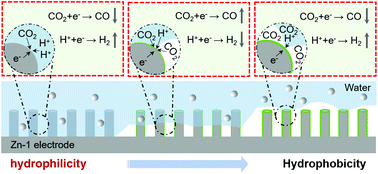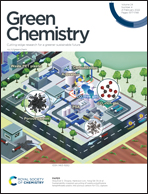Tuning the efficiency and product composition for electrocatalytic CO2 reduction to syngas over zinc films by morphology and wettability†
Abstract
Electrochemical reaction of CO2 and water to produce valuable chemicals and fuels is of great importance. Producing syngas with tunable CO/H2 ratios and high current density is an interesting topic. In this work, Zn films with different morphologies and wettability were fabricated. It was demonstrated that Zn films could be used as efficient electrocatalysts for CO2 reduction to syngas and the CO/H2 ratios could be controlled in the range of 0.09–11.4 changing the morphology and wettability of the catalysts and the applied potential. Particularly, using the nanoleaf Zn film with a water contact angle of 91° as the electrode, the current density could reach 90.4 mA cm−2 with a CO/H2 ratio of 1/1 at −1.27 V vs. RHE. In addition, the maximum FE of CO could reach 92.6% with a current density of 35.3 mA cm−2 at a low overpotential of 440 mV. Detailed studies reveal that the three-dimensional electrode architecture and suitable wettability were favorable for CO2/H+ mass transfer and charge transfer, which are important factors for achieving efficiency.

- This article is part of the themed collection: 2022 Green Chemistry Hot Articles


 Please wait while we load your content...
Please wait while we load your content...